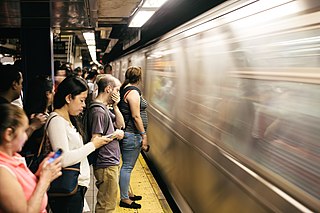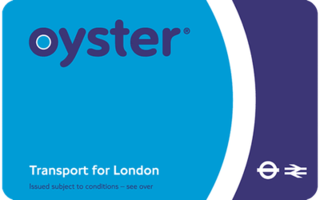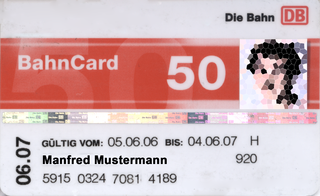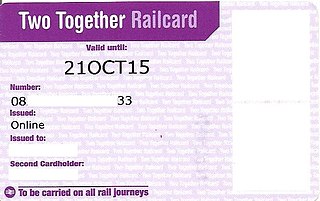| Disability |
|---|
The Disabled Persons Railcard is a concessionary fare scheme in the United Kingdom giving eligible passengers with disabilities benefits on the National Rail network including a 1/3 discount on fares.
| Disability |
|---|
The Disabled Persons Railcard is a concessionary fare scheme in the United Kingdom giving eligible passengers with disabilities benefits on the National Rail network including a 1/3 discount on fares.
The card is available as a one-year validity card for £20 and as a three-year validity card for £54. The Railcard holder can take another adult with them at the same discount rate. [1]
All franchised train operating companies in Great Britain must accept the Railcard and offer discounts under terms set out in the Railways Act 1993. The Railcard is managed by Rail Delivery Group. It is aimed at people who have the most difficulty using rail for a reason relating to their disability. Its purpose is to encourage people to use the train and to reduce the cost for those who need to be accompanied by a carer.
As of July 2022, there are over 228,000 Disabled Persons Railcards in circulation. [2]
British Rail (BR) introduced the Disabled Persons Railcard in 1981 to mark the International Year of Disabled Persons. Sir Peter Parker was Chairman of BR at the time and the British Railways Board included Tom Libby and wheelchair user Bill Buchanan, who was "Special Adviser on the Disabled". [3]
Tom Libby and Bill Buchanan together with Sir Bert Massie (RADAR) were tasked to design and develop the Disabled Persons Railcard.
The Railcard initially cost £5. Its price increased to £14 in the 1990s and then in 2006 to £18. A three-year Railcard was also introduced in September 2006 at £48.
The price increased again in January 2011, to its current cost of £20 for a year. The three year railcard was increased the same year, costing £54 (£18 per year). As of January 2023, [update] these prices are still in effect. [4]
Applicants must submit evidence to show that their disability makes them eligible for a Disabled Persons Railcard.
A passenger is eligible for the Disabled Persons Railcard if they [5]
Historically, the design of most British trains did not enable wheelchair users to travel in the main passenger area. Passenger doors were too narrow and the fixed seating layout did not give wheelchair users space to manoeuvre. When wheelchair users could travel by rail, it was in the guard's van.
The introduction of High Speed Trains and sliding door carriages in the 1970s and 1980s, did much to improve access for disabled passengers, especially with wider doors and priority seating giving people more leg room.
The Disability Discrimination Act 1995 introduced design standards for the future design and construction of public transport vehicles. So, in November 1998 the Rail Vehicle Accessibility Regulations were introduced. These had a significant impact on the design of new trains and refurbishment of existing ones. Rail Vehicle Regulations also formed the basis of the TSI-PRM, a European standard for heavy rail vehicles accessibility.
In 2008, issuing arrangements moved to Scottish contact centre operator, Journeycall, based in Brechin and Laurencekirk. This move also saw the introduction of automated ticket issuing systems and increased call centre opening hours (available between 07.00 and 22.00 every day except Christmas Day). In 2014, Journeycall moved from its Brechin and Laurencekirk offices to a new contact centre at Arbroath. [6]
Railcard holders are issued renewal reminders
Management and marketing of the Railcard is led by the Disability & Inclusion and National Railcards teams at Rail Delivery Group in London.
Discounts and allowances are reductions to a basic price of goods or services.

Accessibility is the design of products, devices, services, vehicles, or environments so as to be usable by people with disabilities. The concept of accessible design and practice of accessible development ensures both "direct access" and "indirect access" meaning compatibility with a person's assistive technology.

A rush hour or peak hour is a part of the day during which traffic congestion on roads and crowding on public transport is at its highest. Normally, this happens twice every weekday: once in the morning and once in the afternoon or evening, the times during which most people commute. The term is often used for a period of peak congestion that may last for more than one hour.

The Oyster card is a payment method for public transport in London in England, United Kingdom. A standard Oyster card is a blue credit-card-sized stored-value contactless smart card. It is promoted by Transport for London (TfL) and can be used on travel modes across London including London Buses, London Underground, the Docklands Light Railway (DLR), London Overground, Tramlink, some river boat services, and most National Rail services within the London fare zones. Since its introduction in June 2003, more than 86 million cards have been used.

A mobility scooter is an electric personal transporter used as mobility aid for people with physical impairment, mostly auxiliary to a powered wheelchair but configured like a motorscooter. When motorized they function micromobility devices and are commonly referred to as a powered vehicle/scooter, or electric scooter. Non-motorized mobility scooters are less common, but are intended for the estimated 60% of wheelchair users who have at least some use of their legs. Whilst leg issues are commonly assumed to be the reason for using scooters, the vehicles are used by those with a wide range of conditions from spinal injuries to neurological disorders.

The Network Railcard is a discount card introduced in 1986 by British Rail, upon the creation of their Network SouthEast sector in parts of Southern England.
There is no single 'discount railcard' available on the UK railway network. In addition to the large number and variety of short-term or localised promotional fares that have been available to passengers on the British railway network in recent decades, there are many permanent concessionary fare schemes available to passengers. Some of these take the form of Railcards, which can be purchased by people who qualify according to the conditions, and which give discounts for all journeys over a period; other concessions are available for individual journeys. In all cases, details of the type of concession will be printed on the passenger's travel ticket, to distinguish reduced-rate tickets from those sold at the standard full fare.

The 16–25 Railcard is an annual card giving discounts on certain types of railway ticket in Britain. It is available to anybody aged between 16 and 25 (inclusive), and certain mature students aged 26 and above, and is currently priced at £30.00. There is no restriction on the number of times the Railcard can be used to purchase discounted tickets during the period of its validity, and there are no geographical restrictions on its use.
Social security, in Australia, refers to a system of social welfare payments provided by Australian Government to eligible Australian citizens, permanent residents, and limited international visitors. These payments are almost always administered by Centrelink, a program of Services Australia. In Australia, most payments are means tested.

The Senior Railcard is an annual card available to people aged 60 and over, which gives discounts on certain types of railway ticket in Britain. The Railcard has existed in various forms since 1975; the current version is priced at £30.00 and is valid for one year, with a 3-year card available for £70. It is one of a wide variety of discounted and concessionary fare schemes available on Britain's railway network.

Laurencekirk railway station is a railway station serving the communities of Laurencekirk and The Mearns in Aberdeenshire, Scotland. The station was reopened on 18 May 2009 at a cost of £3 million. It is sited 210 miles 44 chains (338.8 km) from Carlisle, and is between Montrose and Stonehaven, on the Dundee to Aberdeen line. There is a crossover at the north end of the station, which can be used to facilitate trains turning back if the line south to Montrose is blocked.

BahnCard is a discount subscription programme offered by Deutsche Bahn (DB), the German national railway company. Unlike airline loyalty programs, but similarly to the UK Railcard, the BahnCard entitles the passenger to a discount price and must be purchased prior to travel. The BahnCard is offered in a non-business and a business version called BahnCard Business. Non-business BahnCard contracts are automatically renewed each year, unless they are cancelled with sufficient notice. Three variants of BahnCard are sold by Deutsche Bahn: The BahnCard 25, the BahnCard 50, and the BahnCard 100. The first two variants allow passengers to get 25% and 50% discount respectively on standard long-distance rail fares, while the Mobility BahnCard 100 is a type of annual ticket that allows free unlimited travel on most of the German railway network for a fixed price. The (non-business) BahnCard 25/50 are valid for one year and can only be purchased by subscription. If they are not canceled no later than six weeks before the expiry date, their term is automatically extended by another year. BahnCard Business 25/50 are also valid for one year but require no cancellation. Unlike the personal BahnCard, BahnCard Business can be combined with the discount that is granted to large-volume business customers.
Motability is a charity in the United Kingdom. It oversees Motability Operations Ltd, which runs the Motability Scheme intended to enable disabled people, their families and their carers to lease a new car, scooter or powered wheelchair, using their disability benefit. According to its response to a UK Government inquiry in 2019 into enhancing mobility for handicapped citizens, Motability had over 620,000 customers. According to Citizen's Advice, access to the charity's support to pay for a car is dependent on eligibility relative to mobility conditions in government schemes, including: Disability Living Allowance (DLA), Personal Independence Payment (PIP), Armed Forces Independence Payment (AFIP) or War Pensioners’ Mobility Supplement. Motability's 2019/2020 audit document reported 94% of persons using Motability's scheme to buy a car either have a physical disability or long term health condition. In 2018, the National Audit Office praised the customer satisfaction rates for the service, but criticized the profit and reserve levels the charity held. They also noted criticized its governance and "executive remuneration." A response to a 2019 parliamentary committee to release 343million pounds of its 2.5bn reserve was greeted as a "first step" to making best use of its "vast sums."
Disability Living Allowance (DLA) is a social security benefit in the United Kingdom paid to eligible claimants who have personal care and/or mobility needs as a result of a mental or physical disability. It is tax-free, non-means-tested and non-contributory. The benefit was established by the Social Security Contributions and Benefits Act 1992, integrating the former benefits Mobility Allowance and Attendance Allowance and introducing two additional lower rates of benefit. Prior to 2013 it could be claimed by UK residents aged under sixty five years. However, the benefit was phased-out for the majority of claimants between 2013 and 2015 and replaced by a new Personal Independence Payment. DLA can still be claimed by children under sixteen and can still be received by existing claimants who were aged sixty five or over on 8 April 2013.
Disability benefits are a form of financial assistance designed to support individuals who are unable to work due to a chronic illness, disease or injury. Disability benefits are typically provided through various sources, including government programs, group disability insurance provided by employers or associations or private insurance policies typically purchased through a licensed insurance agent or broker, or directly from an insurance company.

The Rail Vehicle Accessibility Regulations 2010 is a statutory instrument in the United Kingdom. It aims to set standards designed to improve accessibility for disabled people on light rail passenger vehicles.

The European Union Persons with Reduced Mobility (PRM) legislation is intended to ensure that Persons with Reduced Mobility (whether disabled, elderly or otherwise) traveling via public transport, whether by air, land or sea, should have equal access to travel as compared to travelers with unrestricted mobility. Travel providers are compelled to provide and install sufficient access facilities to enable Passenger with Reduced Mobility to enjoy similar access to other passengers (where feasible and with certain safety exemptions).
A reduced fare program refers to special programs providing particular passengers with a discounted fare option for travel on a public transport system. In the United States, public transportation systems that receive federal funding are required to offer, at minimum, half fares to the elderly and handicapped persons during off peak travel. Some transportation systems also extend reduced fare options to youth, students, military personnel, and low-income passengers.

The Two Together Railcard is a scheme which gives discounts on certain types of railway ticket in Britain. Launched nationally in 2014 after a successful trial in 2011–12, it was the first new Railcard scheme since the 1980s. It is available to any two named individuals aged 16 or over and is priced at £30.00. There is no restriction on the number of times the Railcard can be used to purchase discounted tickets during the period of its validity, and there are no geographical restrictions on its use.

Social Security Scotland is an executive agency of the Scottish Government with responsibility for social security provision.